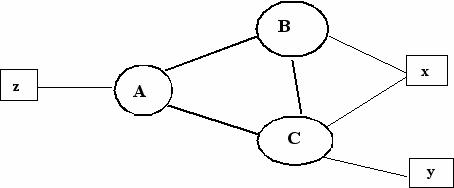- How many sendings alltogether are needed if a separate packet is sent to each receiver?
- How many sendings are needed, if the packet is sent as a multicast packet to each receiver?

- What kind of path information do the BGP routers of these networks exchange with each others, ie. what routes they reveal to the other networks?
- Based on the information available, networks x, y and z form each their own view of the network topology. What are the topology views of the x, y and z?
1 1
B ------------ D ------------ E
| . .|
| . . |
| . . |
| . 2 2 . |
4 | . . | 1
| . . |
| . . |
| . . |
| . . |
A -------- C --------------- F
3 2
Supposing that in the net of the previous problem the cost of the link BD becomes tenfold, that is changes to 10. Find the Steiner tree that connects all the nodes A, B, E and F belonging to the group. It is not necessary to use the Steiner tree construction algorithm. It is enough to inspect the net in order to find the Steiner tree.
B --------------------------------------------- C
| |
E -----|---------------------------- A |
| | | |
| | | |
H -----|------------ I ------------- F --------------- D
| | | . |
| L | . |
| . | . |
| . | . |
| . | . |
| . | . |
| . | . |
|. | . |
K -------- M ------- N -- O -- J --------------------- G